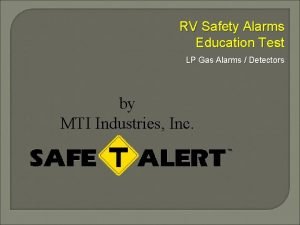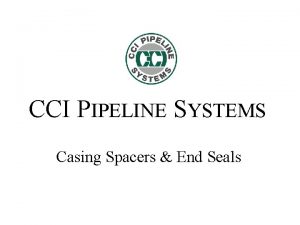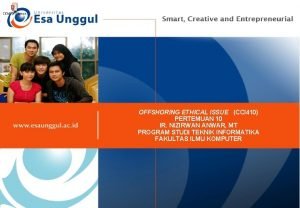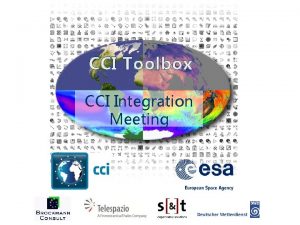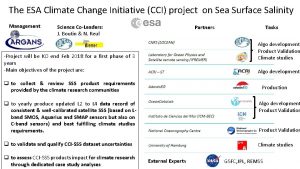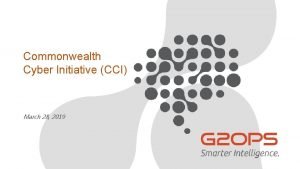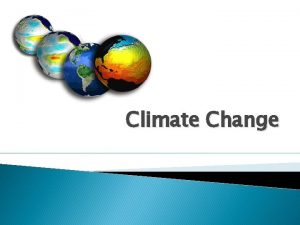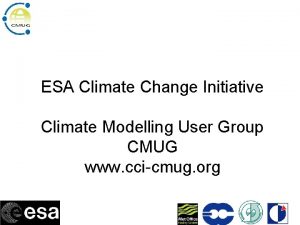ACC5 ESA Climate Change Initiative CCI New ESA










- Slides: 10

ACC-5 ESA Climate Change Initiative (CCI) New ESA Programme with the aim to contribute to worldwide efforts to generate Essential Climate Variables (ECVs) C. Zehner Montreal, 31/03/2010

Two climate action paths GCOS-82 in 2003 GCOS-92 in 2004 GEOSS 10 -year plan in 2005 GCOS-107 in 2006 CEOS response 2006 CEOS IP for GEOSS in 2007

GCOS Global Climate Observing System (GCOS) Report Space Agencies agreed to take actions on 26 ECVs

ENVISAT Lifetime and Operations Extension 2008 ERS-2 SAR ATSR Altimetry GOME 2009 2010 2011 2012 2013 2014 Envisat Sentinel-1 a ASAR MERIS AATSR Altimetry GOMOS SCIAMACHY MIPAS Scatt Met. Op Launch end 2011 Risk of data gap & Sentinel-1 b Sentinel-3 a Launch early 2013 Need of back-up Sentinel-3 b Sentinel-4 Sentinel-Pre/5 Earth Explorer Missions (SMOS, EARTHCARE, …) ESA TPMs (Scisat, Odin, GOSAT, …) Based on existing missions ESA could contribute to 18 ECVs

CCI Objectives To realize the full potential of the long-term global Earth Observation archives that ESA together with its Member states have established over the last thirty years, as a significant and timely contribution to the ECV databases required by United Nations Framework Convention on Climate Change (UNFCCC). • Implement all steps necessary for the systematic generation and regular updating of the relevant ECVs, • A coherent and continuous suite of actions fully coordinated with on-going international efforts in the climate change community (eg. WCRP, IGBP, SCOPE, etc) • Ensure full capital is derived from on-going & planned ESA missions for climate purposes • Duration 6 years (2009 – 2015): Budget 75 Meuro • Initial Focus on 11 ECVs

11 selected ECVs 11 Sea-level ECVs Sea Surface Temperature Sea Ice Ocean Colour Land Cover Fire Disturbance Glaciers and Ice Caps Cloud Properties Aerosol Properties Ozone Greenhouse Gases (CO 2, CH 4)

ECV Feedback Loops Long Term Archiving Programmes Multi-mission infrastructure INPUT FROM FEEDBACK LOOP: Re-processing ex archive (e. g. calibration) 6 year programme for 2 phases “Gather” “Deliver” ECV generation (e. g. validation & bias) ECV assimilation & assessment “Exploit” OUTPUT TO International Climate Programmes EC & MS R&D Programmes IPCC Process, UNFCCC Education & Awareness “Show”

International Coordination • UNFCCC which coordinates the interests and decisions of its Parties on Climate Policy, • GCOS which represents the scientific and technical requirements of the Global Climate Observing System on behalf of UNFCCC, • CEOS which serves as a focal point for Earth Observation related activities of Space Agencies, • Individual Partner Space Agencies with whom ESA cooperates bilaterally, • International Climate Research Programmes, which represent the collective interests and priorities of the worldwide climate research, • EC and National Research Programmes which establish research priorities and provide resources for climate research community within Europe.

Programme: First Phase • First Phase has a duration of 3 years: Definition, Algorithm Development, Protoyping Phase – 25 MEuro • All ESA Programmes are implemented via contracts with industry and research organizations in ESA states • Contracts are awarded via open competitive tender – CCI ITT to has been closed, 11 contracts on ECVs to start during the next months and 1 additional contract interacting with Key Climate Modelling Groups

What has do be done in Phase 1: Task 1: Scientific Requirements Analysis and Detailed Specifications The objective is using the GCOS documentation to identify in detail the technical requirements and specifications for the relevant ECV data product and the interface to the Earth system science and climate modelling community that ultimately will exploit such products. Task 2: Algorithm Development, Validation and Inter-comparison The objective of this task is to develop, test and validate the necessary algorithms to generate the high quality (multi-sensor) FCDRs and the derived ECV data products required by the end-users and matching the GCOS performance requirements (L 1, L 2 and data merging algorithms including detailed error characterisation). Parallel Algorithms development is encouraged. Task 3: System Prototyping and FCDR and ECV Production Given development of the algorithm(s) in task 2 this task will comprise the development of the software prototype and production of the necessary ECV products for Task 4: Final Product Validation and User Assessment Characterisation and comprehensive validation of the ECV products with scientific rigour is a fundamental issue and a very considerable task necessary to provide the high quality long term ECV products as requested by the end users and GCOS. Task 5: System Specification for Phase 2 Task 6: Management



